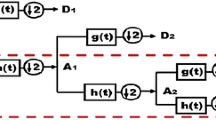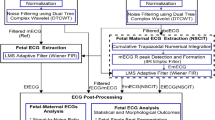Abstract
Fetal arrhythmia, the abnormal heartbeat of a fetus is broadly classified as tachy arrhythmia (too fast > 160 beats/min) and brady arrhythmia (too slow < 120 beats/min). Detection of this irregular heart beat rhythm of the fetus during pregnancy is still a challenging task for the clinicians. Heart rate detection through electrocardiography has always been accurate for identifying cardiac defect in humans. Adult ECG has achieved several developments in the modern medicine whereas noninvasive fetal ECG (FECG) continues to be a big challenge. Automatic detection of fetal heart rate is vital for monitoring the unborn infant during pregnancy. The non-invasive placement of electrodes over the abdomen region of pregnant women records the ECG signal of both mother and fetus. The arrhythmia affected FECG signals (n = 14) are processed from the physionet database. This raw ECG signal is preprocessed using a Savitzky-Golay filter and symlet wavelet transform to remove the basic noises. Adaptive recursive least square filter is preferably chosen for extracting the FECG, using mother’s thorax ECG as a reference. An accurate PQRST wave-shape of the FECG is required for the proper diagnosis of fetal cardiac defects. Using a single channel abdominal ECG signal, the proposed work generates extracted fetal ECG and an automated visual display of fetal heart rate. The presence of arrhythmia and fetal distress can be analyzed through fetal heart rate display and abnormal conductivity of PQRST wave respectively. We have analyzed fetal arrhythmias through ECG extraction and the same was compared with the echocardiograph results given by pediatric cardiologist. This study helps to identify the fetal distress at early gestational age that helps the obstetricians to make quick decisions before or immediately after delivery.







Similar content being viewed by others
Data availability
References
Tanel RE, Rhodes LA (2001) Fetal and neonatal arrhythmias. Clin Perinatol 28(1):187–207
Jaeggi E, Ohman A (2016) Fetal and neonatal arrhythmias. Clin Perinatol 43:99–112
Lindsey DA (1993) Congenital heart disorders in the fetus. Fetal Matern Med Rev 5(1):39–44
Comani S, Mantini D, Pennesi P, Lagatta A, Cancellieri G (2004) Independent component analysis: fetal signal reconstruction from magnetocardiographic recordings. Comput Methods Progr Biomed 75(2):163–177
Gobillot S, Fontecave-Jallon J, Equy V, Rivet B, Gumery PY, Hoffmann P (2018) Non-invasive fetal monitoring using electrocardiography and phonocardiography: a preliminary study. J Gynecol Obstetr Hum Reprod 47(9):455–459
Gupta M, Gupta P (2016) Role of cardiotocography in high risk pregnancy and its correlation with increase cesarean section rate. Int J Reprod Contracept Obstetr Gynecol 6(1):168–171
Taralunga DD, Ungureanu GM, Gussi I, Strungaru R, Wolf W (2014) Fetal ecg extraction from abdominal signals a review on suppression of fundamental power line interference component and its harmonics. In: Gao W, Wang W (eds) Computational and mathematical methods in medicine. Hindawi Publishing Corporation, London, pp 1–15
Clifford GD, Silva I, Behar J, Moody GB (2014) Non-invasive fetal ECG analysis. Physiol Meas 35(8):1521–1536
Sänger N et al (2012) Prenatal foetal non-invasive ECG instead of Doppler CTG - a better alternative? Geburtshilfe Frauenheilkd 72(7):630–633
Kaneko M et al (2011) Application of a fetal scalp electrode for continuous fetal heart rate monitoring during an ex utero intrapartum treatment. J Pediatr Surg 46(2):e37–e40
Sameni R, Clifford GD (2010) A review of fetal ECG signal processing; issues and promising directions. Open Pac Electrophysiol Ther J 3:4–20
Taralunga DD, Ungureanu GM, Gussi I, Strungaru R, Wolf W (2014) Fetal ECG extraction from abdominal signals: a review on suppression of fundamental power line interference component and its harmonics. Comput Math Methods Med 2014:1–15
Behar J, Bonnemains L, Shulgin V, Oster J, Ostras O, Lakhno I (2019) Non-invasive fetal electrocardiography for the detection of fetal arrhythmias. Prenat Diagn 39(3):178–187
Suganthy M, Manjula S (2018) Enhancement of SNR in fetal ECG signal extraction using combined SWT and WLSR in parallel EKF. Clust Comput 22:3875–3881
Houssein EH, Hassanien AE, Kilany M (2017) ECG signals classification: a review. Int J Intell Eng Inform 5(4):376–396
Acharya D, Rani A, Agarwal S, Singh V (2016) Application of adaptive Savitzky-Golay filter for EEG signal processing. Perspect Sci 8:677–679
Ross MG, Devoe LD, Rosen KG (2004) ST-segment analysis of the fetal electrocardiogram improves fetal heart rate tracing interpretation and clinical decision making. J Matern-Fetal Neonatal Med 15(3):181–185
Goldberger AL et al (2000) PhysioBank, PhysioToolkit, and PhysioNet: components of a new research resource for complex physiologic signals. Circulation 101(23):e215–e220
Li S, Liu G, Lin Z (2009) Comparisons of wavelet packet, lifting wavelet and stationary wavelet transform for de-noising ECG. In: 2009 2nd IEEE international conference on computer science and information technology, Beijing, pp 491–494. https://doi.org/10.1109/ICCSIT.2009.5234650
Schafer RW (2011) What is a savitzky-golay filter? [lecture notes]. IEEE Signal Process Mag 28(4):111–117
Suganthy M, Immaculate Joy S (2019) Analysis of R - peaks in fetal electrocardiogram to detect heart disorder using fuzzy clustering. In: presented at the IEEE 5th international conference for convergence in technology, Pune, India. https://doi.org/10.1109/I2CT45611.2019.9033732
Gubbi J, Khandoker A, Palaniswami M (2011) Classification of sleep apnea types using wavelet packet analysis of short-term ECG signals. J Clin Monit Comput 26(1):1–11
Hess OW (1980) Impact of electronic fetal monitoring on obstetric management. JAMA 244(7):682–686
Strasburger JF, Wakai RT (2010) Fetal cardiac arrhythmia detection and in utero therapy. Nat Rev Cardiol 7(5):277–290
Suganthy M, Immaculate Joy S, Sarala B (2019) LabVIEW based non-invasive single channel Fetal Electrocardiogram Extraction. In: 2019 IEEE 1st international conference on energy, systems and information processing (ICESIP), Chennai, India, pp 1–5. https://doi.org/10.1109/ICESIP46348.2019.8938262
Martinek R et al (2017) Non-invasive fetal monitoring: a maternal surface ECG electrode placement-based novel approach for optimization of adaptive filter control parameters using the LMS and RLS algorithms. Sensors (Basel) 17(5):1–31
Wang Y, Wu W, Zhu Q, Shen G (2011) Discrete wavelet transform for nonstationary signal processing, discrete wavelet transforms – theory and applications. ISBN: 978-953-307-185
Rhose S, Heinis AMF, Vandenbussche F, van Drongelen J, van Dillen J (2014) Inter- and intra-observer agreement of non-reassuring cardiotocography analysis and subsequent clinical management. Acta Obstet Gynecol Scand 93:596–602
Westerhuis ME et al (2007) A randomised clinical trial on cardiotocography plus fetal blood sampling versus cardiotocography plus ST-analysis of the fetal electrocardiogram (STAN) for intrapartum monitoring. BMC Pregnancy Childbirth 7(13):1–7
Hasan MA, Reaz MB, Ibrahimy MI, Hussain MS, Uddin J (2009) Detection and processing techniques of FECG signal for fetal monitoring. Biol Proced Online 11:263–295
Castillo E, Morales DP, Botella G, García A, Parrilla L, Palma AJ (2013) Efficient wavelet-based ECG processing for single-lead FHR extraction. Digital Signal Process 23(6):1897–1909
Knotts RJ, Garan H (2014) Cardiac arrhythmias in pregnancy. Semin Perinatol 38(5):285–288
Alfirevic Z, Devane D, Gyte GM (2017) Continuous cardiotocography (CTG) as a form of electronic fetal monitoring (EFM) for fetal assessment during labour. Cochrane Database Syst Rev 2(2):95–99
Al-Sheikh B, Salman MS, Eleyan A, Alboon S (2019) Non-invasive fetal ECG extraction using discrete wavelet transform recursive inverse adaptive algorithm. Technol Health Care 28(5):507–520
Mousavian I, Shamsollahi MB, Fatemizadeh E (2019) Noninvasive fetal ECG extraction using doubly constrained block-term decomposition. Math Biosci Eng 17(1):144–159
Zhang Y, Yu S (2020) Single-lead noninvasive fetal ECG extraction by means of combining clustering and principal components analysis. Med Biol Eng Comput 58(2):419–432
Billeci L, Varanini MA (2016) Combined independent source separation and quality index optimization method for fetal ECG extraction from abdominal maternal leads. Sensors (Basel) 17(5):1–20
Martinek R et al (2018) Comparative effectiveness of ICA and PCA in extraction of fetal ECG from abdominal signals: toward non-invasive fetal monitoring. Front Physiol 9(648):1–25
Ghazdali A, Hakim A, Laghrib A, Mamouni N, Raghay S (2015) A new method for the extraction of fetal ECG from the dependent abdominal signals using blind source separation and adaptive noise cancellation techniques. Theor Biol Med Model. https://doi.org/10.1186/s12976-015-0021-2
Funding
This work was supported by, Science and Engineering Research Board (SERB), Department of Science and Technology (DST) – India. Reference Number (EEQ/2017/000421).
Author information
Authors and Affiliations
Corresponding author
Ethics declarations
Conflict of interest
All authors propose no conflict of interest.
Ethical approval
This article does not contain any studies with human participant or animals performed by any of the authors.
Additional information
Publisher's Note
Springer Nature remains neutral with regard to jurisdictional claims in published maps and institutional affiliations.
Rights and permissions
About this article
Cite this article
Suganthy, M., Joy, S.I. & Anandan, P. Detection of fetal arrhythmia by adaptive single channel electrocardiogram extraction. Phys Eng Sci Med 44, 683–692 (2021). https://doi.org/10.1007/s13246-021-01016-z
Received:
Accepted:
Published:
Issue Date:
DOI: https://doi.org/10.1007/s13246-021-01016-z




